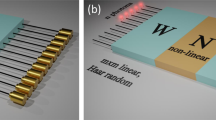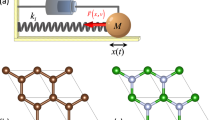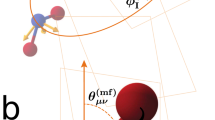Abstract
Plausible claims for quantum advantage have been made using sampling problems such as random circuit sampling in superconducting qubit devices, and Gaussian boson sampling in quantum optics experiments. Now, the major next step is to channel the potential quantum advantage to solve practical applications rather than proof-of-principle experiments. It has recently been proposed that a Gaussian boson sampler can efficiently generate molecular vibronic spectra, which are an important tool for analysing chemical components and studying molecular structures. The best-known classical algorithm for calculating the molecular spectra scales super-exponentially in the system size. Therefore, an efficient quantum algorithm could represent a computational advantage. However, here we propose an efficient quantum-inspired classical algorithm for molecular vibronic spectra with harmonic potentials. Using our method, the zero-temperature molecular vibronic spectra problems that correspond to Gaussian boson sampling can be exactly solved. Consequently, we demonstrate that those problems are not candidates for quantum advantage. We then provide a more general molecular vibronic spectra problem, which is also chemically well motivated, for which our method does not work and so might be able to take advantage of a boson sampler.
This is a preview of subscription content, access via your institution
Access options
Access Nature and 54 other Nature Portfolio journals
Get Nature+, our best-value online-access subscription
$29.99 / 30 days
cancel any time
Subscribe to this journal
Receive 12 print issues and online access
$209.00 per year
only $17.42 per issue
Buy this article
- Purchase on Springer Link
- Instant access to full article PDF
Prices may be subject to local taxes which are calculated during checkout


Similar content being viewed by others
Data availability
Source data are provided with this paper.
References
Nielsen, M. A. & Chuang, I. Quantum Computation and Quantum Information (Cambridge Univ. Press, 2002).
Shor, P. W. Algorithms for quantum computation: discrete logarithms and factoring. In Proc. 35th Annual Symposium on Foundations of Computer Science 124–134 (IEEE, 1994).
Lloyd, S. Universal quantum simulators. Science 273, 1073–1078 (1996).
Arute, F. et al. Quantum supremacy using a programmable superconducting processor. Nature 574, 505–510 (2019).
Wu, Y. et al. Strong quantum computational advantage using a superconducting quantum processor. Phys. Rev. Lett. 127, 180501 (2021).
Zhong, H.-S. et al. Quantum computational advantage using photons. Science 370, 1460–1463 (2020).
Zhong, H.-S. et al. Phase-programmable Gaussian boson sampling using stimulated squeezed light. Phys. Rev. Lett. 127, 180502 (2021).
Madsen, L. S. et al. Quantum computational advantage with a programmable photonic processor. Nature 606, 75–81 (2022).
Huh, J., Guerreschi, G. G., Peropadre, B., McClean, J. R. & Aspuru-Guzik, A. Boson sampling for molecular vibronic spectra. Nat. Photon. 9, 615–620 (2015).
Barone, V., Bloino, J. & Biczysko, M. Vibrationally-resolved electronic spectra in Gaussian 09. Rev. A 02, 1 (2009).
Hamilton, C. S. et al. Gaussian boson sampling. Phys. Rev. Lett. 119, 170501 (2017).
Aaronson, S. & Arkhipov, A. The computational complexity of linear optics. In Proc. Forty-Third Annual ACM Symposium on Theory of Computing 333–342 (ACM, 2011).
Deshpande, A. et al. Quantum computational advantage via high-dimensional Gaussian boson sampling. Sci. Adv. 8, eabi7894 (2022).
Arrazola, J. et al. Quantum circuits with many photons on a programmable nanophotonic chip. Nature 591, 54–60 (2021).
Shen, Y. et al. Quantum optical emulation of molecular vibronic spectroscopy using a trapped-ion device. Chem. Sci. 9, 836–840 (2018).
Paesani, S. et al. Generation and sampling of quantum states of light in a silicon chip. Nat. Phys. 15, 925–929 (2019).
Wang, C. S. et al. Efficient multiphoton sampling of molecular vibronic spectra on a superconducting bosonic processor. Phys. Rev. X 10, 021060 (2020).
Quesada, N. & Arrazola, J. M. Exact simulation of Gaussian boson sampling in polynomial space and exponential time. Phys. Rev. Research 2, 023005 (2020).
Wu, B. et al. Speedup in classical simulation of Gaussian boson sampling. Sci. Bull. 65, 832–841 (2020).
Bulmer, J. F. F. et al. The boundary for quantum advantage in Gaussian boson sampling. Sci. Adv. 8, eabl9236 (2022).
Quesada, N. et al. Quadratic speed-up for simulating Gaussian boson sampling. PRX Quantum 3, 010306 (2022).
Oh, C., Lim, Y., Fefferman, B. & Jiang, L. Classical simulation of boson sampling based on graph structure. Phys. Rev. Lett. 128, 190501 (2022).
Drucker, A. & de Wolf, R. Quantum proofs for classical theorems. Theory Comput. Grad. Surv. 2, 1–54 (2011).
Shin, S. W., Smith, G., Smolin, J. A. & Vazirani, U. How ‘quantum’ is the D-Wave machine? Preprint at https://arxiv.org/abs/1401.7087 (2014).
Heim, B., Rønnow, T. F., Isakov, S. V. & Troyer, M. Quantum versus classical annealing of Ising spin glasses. Science 348, 215–217 (2015).
Tang, E. A quantum-inspired classical algorithm for recommendation systems. In Proc. 51st Annual ACM SIGACT Symposium on Theory of Computing 217–228 (ACM, 2019).
Gilyén, A., Lloyd, S. & Tang, E. Quantum-inspired low-rank stochastic regression with logarithmic dependence on the dimension. Preprint at https://arxiv.org/abs/1811.04909 (2018).
Aaronson, S. Chinese BosonSampling experiment: the gloves are off. https://scottaaronson.blog/?p=5159 (2020).
Doktorov, E., Malkin, I. & Man’Ko, V. Dynamical symmetry of vibronic transitions in polyatomic molecules and the Franck-Condon principle. J. Mol. Spectrosc. 64, 302–326 (1977).
Gurvits, L. On the complexity of mixed discriminants and related problems. In International Symposium on Mathematical Foundations of Computer Science 447–458 (Springer, 2005).
Aaronson, S. & Hance, T. Generalizing and derandomizing Gurvits’s approximation algorithm for the permanent. Quantum Inf. Comput. 14, 541–559 (2014).
Hassanieh, H., Indyk, P., Katabi, D. & Price, E. Nearly optimal sparse Fourier transform. In Proc. Forty-Fourth Annual ACM Symposium on Theory of Computing 563–578 (ACM, 2012).
Drummond, P. & Gardiner, C. Generalised p-representations in quantum optics. J. Phys. A: Math. Gen. 13, 2353 (1980).
Drummond, P. D., Opanchuk, B., Dellios, A. & Reid, M. D. Simulating complex networks in phase space: Gaussian boson sampling. Phys. Rev. A 105, 012427 (2022).
Janszky, J. & Vinogradov, A. V. Squeezing via one-dimensional distribution of coherent states. Phys. Rev. Lett. 64, 2771 (1990).
Vargas-Martínez, J., Moya-Cessa, H. & Fernández Guasti, M. Normal and anti-normal ordered expressions for annihilation and creation operators. Rev. Mex. Fis. E 52, 13 (2006).
Walls, D. F. & Milburn, G. J. Quantum Optics (Springer Science & Business Media, 2007).
Huh, J. & Yung, M.-H. Vibronic boson sampling: generalized Gaussian boson sampling for molecular vibronic spectra at finite temperature. Sci. Rep. 7, 7462 (2017).
Baiardi, A., Bloino, J. & Barone, V. General time dependent approach to vibronic spectroscopy including Franck-Condon, Herzberg-Teller, and Duschinsky effects. J. Chem. Theory Comput. 9, 4097–4115 (2013).
Huh, J. & Berger, R. Coherent state-based generating function approach for Franck–Condon transitions and beyond. In Journal of Physics: Conference Series 380, 012019 (IOP Publishing, 2012).
Hollas, J. M. High Resolution Spectroscopy (Butterworth-Heinemann, 2013).
Hollas, J. M. Modern Spectroscopy (John Wiley & Sons, 2004).
Braunstein, S. L. Squeezing as an irreducible resource. Phys. Rev. A 71, 055801 (2005).
Björklund, A., Gupt, B. & Quesada, N. A faster hafnian formula for complex matrices and its benchmarking on a supercomputer. ACM J. Exp. Algorithmics 24, 1–17 (2019).
Quesada, N. Franck-Condon factors by counting perfect matchings of graphs with loops. J. Chem. Phys. 150, 164113 (2019).
Barvinok, A. I. Two algorithmic results for the traveling salesman problem. Math. Oper. Res. 21, 65–84 (1996).
Barvinok, A. Combinatorics and Complexity of Partition Functions Vol. 9 (Springer, 2016).
Kan, R. From moments of sum to moments of product. J. Multivar. Anal. 99, 542–554 (2008).
Jnane, H. et al. Analog quantum simulation of non-Condon effects in molecular spectroscopy. ACS Photonics 8, 2007 (2021).
Jahangiri, S., Arrazola, J. M., Quesada, N. & Delgado, A. Quantum algorithm for simulating molecular vibrational excitations. Phys. Chem. Chem. Phys. 22, 25528 (2020).
Sparrow, C. et al. Simulating the vibrational quantum dynamics of molecules using photonics. Nature 557, 660–667 (2018).
McArdle, S., Mayorov, A., Shan, X., Benjamin, S. & Yuan, X. Digital quantum simulation of molecular vibrations. Chem. Sci. 10, 5725–5735 (2019).
Sawaya, N. P. & Huh, J. Quantum algorithm for calculating molecular vibronic spectra. J. Phys. Chem. Lett. 10, 3586–3591 (2019).
Sawaya, N. P., Paesani, F. & Tabor, D. P. Near- and long-term quantum algorithmic approaches for vibrational spectroscopy. Phys. Rev. A 104, 062419 (2021).
Acknowledgements
We thank N. Quesada, J. Huh, S. Irani, B. O’Gorman, J. Whitfield and N. Sawaya for interesting and fruitful discussions. B.F. acknowledges support from AFOSR (YIP nos. FA9550-18-1-0148 and FA9550-21-1-0008). This material is based on work partially supported by the National Science Foundation (NSF) under Grant CCF-2044923 (CAREER) and by the US Department of Energy (DOE), Office of Science, National Quantum Information Science Research Centers, as well as by DOE QuantISED grant DE-SC0020360. We acknowledge support from the ARO (W911NF-18-1-0020 and W911NF-18-1-0212), ARO MURI (W911NF-16-1-0349 and W911NF-21-1-0325), AFOSR MURI (FA9550-19-1-0399 and FA9550-21-1-0209), AFRL (FA8649-21-P-0781), DOE Q-NEXT, NSF (EFMA-1640959, OMA-1936118, EEC-1941583, OMA-2137642), NTT Research and the Packard Foundation (2020-71479). This research was supported in part by the NSF under PHY-1748958. Y.L. acknowledges the National Research Foundation of Korea for a grant funded by the Ministry of Science and ICT (NRF-2020M3E4A1077861) and KIAS Individual Grant (CG073301) at the Korea Institute for Advanced Study. We also acknowledge the University of Chicago’s Research Computing Center for their support of this work.
Author information
Authors and Affiliations
Contributions
C.O., Y.L. and Y.W. developed the theory, and C.O. wrote the paper. B.F. and L.J. directed the research and developed the theory. All authors edited the paper.
Corresponding author
Ethics declarations
Competing interests
The authors declare no competing interests.
Peer review
Peer review information
Nature Physics thanks Alexandra Moylett and the other, anonymous, reviewer(s) for their contribution to the peer review of this work.
Additional information
Publisher’s note Springer Nature remains neutral with regard to jurisdictional claims in published maps and institutional affiliations.
Supplementary information
Supplementary Information
Supplementary Sections 1–10 and Fig. 1.
Source data
Source Data Fig. 2
Source data for the molecular vibronic spectra.
Rights and permissions
Springer Nature or its licensor (e.g. a society or other partner) holds exclusive rights to this article under a publishing agreement with the author(s) or other rightsholder(s); author self-archiving of the accepted manuscript version of this article is solely governed by the terms of such publishing agreement and applicable law.
About this article
Cite this article
Oh, C., Lim, Y., Wong, Y. et al. Quantum-inspired classical algorithms for molecular vibronic spectra. Nat. Phys. 20, 225–231 (2024). https://doi.org/10.1038/s41567-023-02308-9
Received:
Accepted:
Published:
Issue Date:
DOI: https://doi.org/10.1038/s41567-023-02308-9



